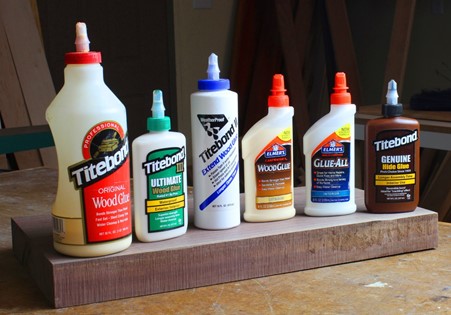There are often debates among woodworkers as to which glue is the best overall glue to use. When you choose a glue for any given woodworking project, it’s important to understand the characteristics that are important to you. For me, this can range dramatically from project to project, and I commonly use multiple glues on a single project, with different goals for various joints.
Bond strength comparisons of wood glue is a meaningless exercise.
Well, of course bond strength is important, but the practical way to grade it is on a pass/fail system, and all commercially available wood glue products that I’m aware of provide bonding strength that exceeds the strength characteristics of the wood fiber itself as long as you’ve properly executed the glue joint.
In other words, as long as you take the time and execute good tight joinery using a table saw and jointer, use appropriate clamping pressure and leave the wood in clamps until the glue is set, your glue joint will be stronger than the boards that you glued together. So, every wood glue that I’m familiar with gets a passing grade on bond strength.
As a proof point of this, you can watch George Vondriska break a glued-up panel of boards, and the break occurs along the weakest path of the wood fiber rather than on the glue joint.
Assembly time matters; A LOT!
Most of the time when I’m choosing between the glue options that I maintain in my shop, the driving factor is how much working time I will need.
If a joint is simple and I want to glue it together and be able to keep moving through the project, I reach for Titebond Original. In my tests I found it to have a maximum working time of 11 minutes.
After 30-60 minutes of clamp time the joint is already stronger than the surrounding wood fibers, even though full cure doesn’t occur for 24 hours.
Titebond II Premium is apparently rated for even shorter assembly time, but I didn’t have any on hand when I did my tests, and it is very closely aligned to Titebond Original in terms of assembly time.
If I want an elongated assembly time, I will reach for Elmer’s Glue-All. This is a PVA based glue, so it is made of the same stuff as the same adhesive properties as other PVA glues (including bond strength), but it doesn’t have the curing accelerant or waterproof additives that other products might have.
With its dirt-cheap price, it’s worth having a bottle of this stuff on hand because it can introduce a sense of calm during a complicated glue-up.
Hide glue offers even more open time, but I rarely find that I need that much time, even for the most complicated glue-ups. It is also a lot more expensive and has shorter shelf life than most PVA glues.
Here are the results of some assembly time tests that I did using a variety of glue products:

Special Circumstances
Water resistance
If you are building projects that will be commonly exposed to water, such as cutting boards or outdoor furniture, then you will have to take that into consideration as you buy your glue.
In the Titebond family, Titebond Premium is considered to be weatherproof, while Titebond III Ultimate and Elmer’s Wood glue are rated as waterproof, which means that they can withstand more exposure to water.
In reality, all PVA glues provide some level of moisture resistance after complete cure has occurred, so it isn’t as though your project will fall apart if you used a glue that isn’t rated as waterproof. But if you know that your project will see some water, more insurance is better.
Food Safety
If you make cutting boards or other items that will come in contact with food, you will want to use a product such as Titebond II or III that are both water resistant and FDA approved for food contact after cured.
Sloppy Joinery
Often times people look at the gap-filling characteristics of a wood glue, and choose the best gap filler to overcome poor joinery.
Polyurethane glue and epoxy both make claims of bridging a gap and forming a bond where the joinery is sloppy. In my opinion, you are far better off repairing a poorly executed joint and using PVA based glue than relying on a so-called gap-filling glue.
These glues might be able to overcome a slightly larger gap than PVA glues, but the difference isn’t nearly as great as what many woodworkers believe. Good sound joinery wins every time.
Recommendations
I suggest having a few options in your arsenal so that you have options for any situation. Get a larger size for your go-to glue, and smaller sizes of others.
I use Titebond Ultimate III about 90% of the time primarily based on its waterproof and food safe characteristics, and an open assembly time that is adequate for most situations.

For a quick-set glue I use Titebond Original; that stuff is cheap, sets up quickly, and lets me make more progress in a day when my joinery is simple.

For a slow-cook option for complicated glue-ups, I grab Elmer’s Glue-All. The extra assembly time is great, and the low price makes it an easy choice to keep on hand.





